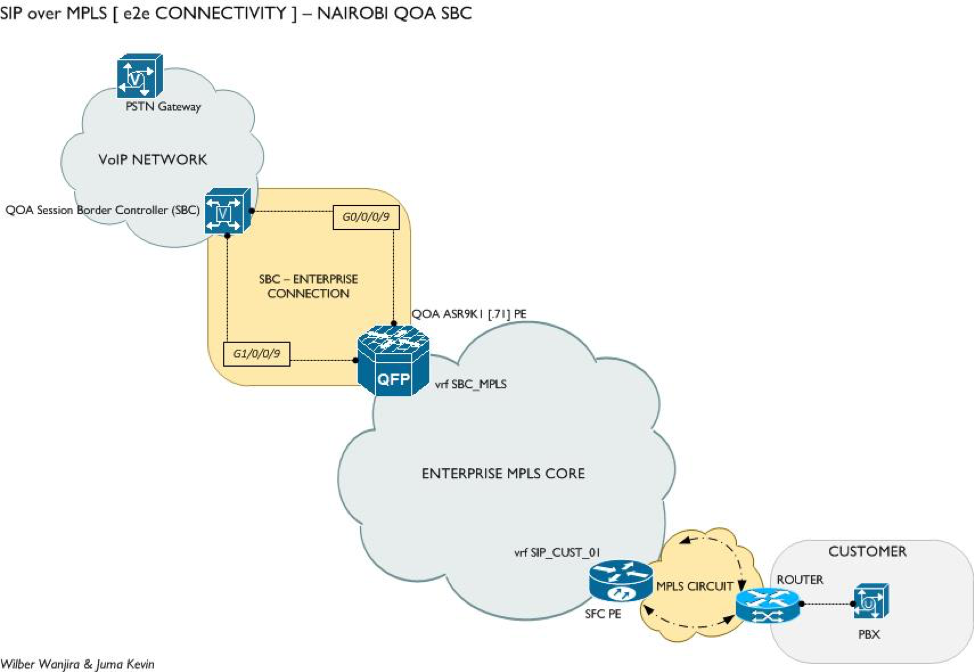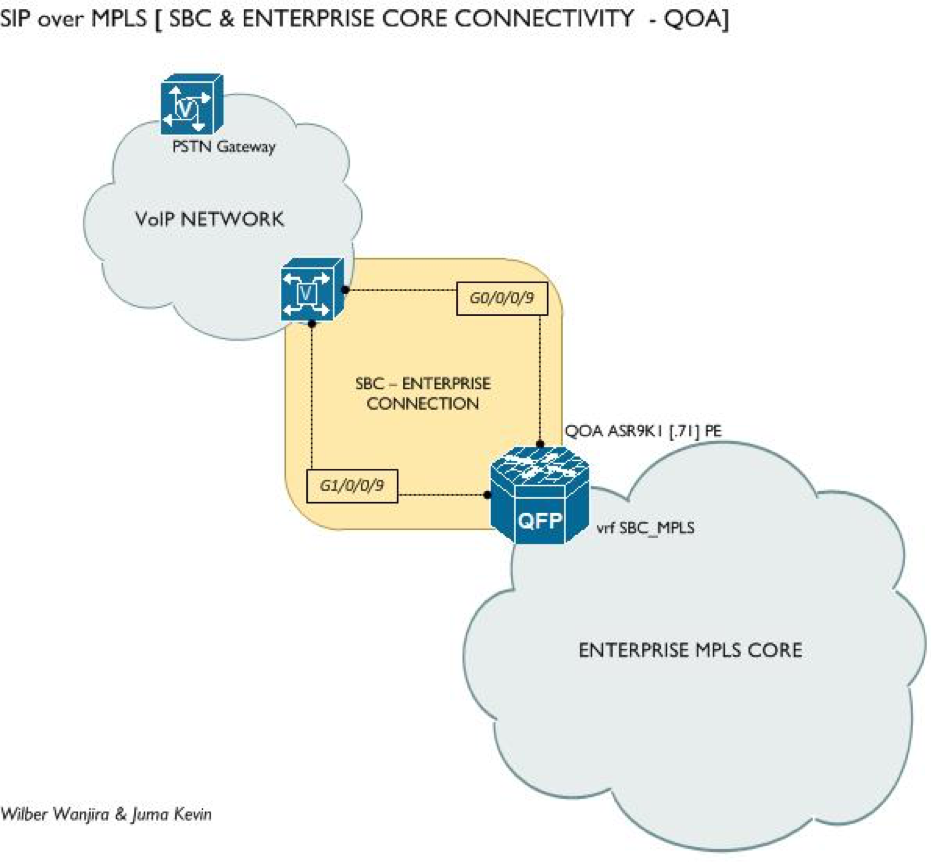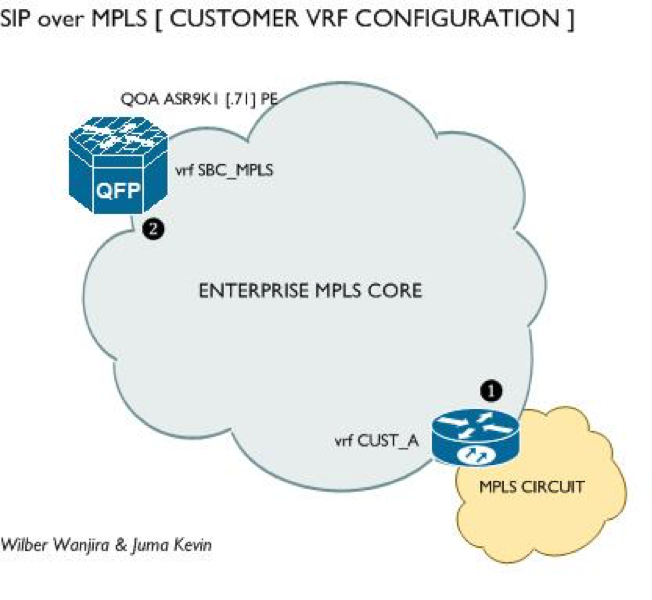SIP over MPLS - Service Implementation
Aug 17, 2015 · 1038 words · 5 minutes read
Principal Engineer - Integration1 and Senior Engineer - Core Planning (Voice)2
Introduction
In this document, we share the deployed network architecture to provide SIP over MPLS. This model adopts the SIP protocol as signaling to set up a call and MPLS as a core network forwarding mechanism. SIP over MPLS will provide an alternative to SIP over dedicated Internet Access (the current and more typical deployment approach).
The benefits of running SIP over MPLS
- Cross Platform Deployment - Unlocks deploying SIP over LTE, WIMAX & BESPOKE Solutions
- Security; MPLS avoids exposure to the public internet, making SIP over MPLS more secure than over other transport options.
- Improved call quality with low latency.
- Less jitter
- Better capacity control
- End-to-End Quality of Service; MPLS will transport SIP using labels that will define the destination (Session Border Controller (SBC)) and the class of service it should receive. (explicit null)
- Avoiding usage of public IPs which are limited resources
- Ease of implementation as complex router configurations (over public deployments) are not required.
- DRVS: Disaster Recovery Voice Signaling - Have the larger customer connected to both SBCs for redundancy. .
Core Configuration & Layout
Deployed e2e SIP Service delivery over MPLS [Schematic]
Connectivity between the SBC and Enterprise Core [Schematic & Configurations]
Physical & Logical Layout
| Ports | IP | Description |
|---|---|---|
| GigabitEthernet0/0/0/9 | x | primary physical link to SBC |
| GigabitEthernet1/0/0/9 | x | secondary physical link to SBC |
| Bundle-Ether555 | 10.66.56.224/30 | primary logical link to SBC |
| Bundle-Ether556 | 10.66.56.228/30 | secondary logical link to SBC |
| x | 10.66.56.138/32 | SBC Signaling |
| x | 10.65.83.97/32 | SBC Media |
QOA SBC PE Interface IPs
#physical interfaces configuration
interface GigabitEthernet1/0/5
description to EBT_ASR_PE01 G0/0/0/9
undo shutdown
ip address 10.66.56.225 255.255.255.252
interface GigabitEthernet2/0/5
description to EBT_ASR_PE02 G0/0/0/9
undo shutdown
ip address 10.66.56.229 255.255.255.252#logical interface and route configuration
interface signal-if 3/0/4
description EBT_Signal_Service_IP
ip address 10.66.56.138 255.255.255.255
quit
ip route-static 10.221.0.0 255.255.255.0 10.66.56.226 description EBT_ASR_Signal
ip route-static 10.221.0.0 255.255.255.0 10.66.56.230 description EBT_ASR_Signal
sbc wellknownport clientaddr 10.66.56.138 sip 5060SIP Trunk Configurations
#QOAGTMSS
ADD OFC: ON="EBTTEST_SIP", OOFFICT=CMPX, DOL=SAME, BOFCNO=1099, OFCTYPE=COM, SIG=SIP, SVQE=NO;
ADD BILLCTRL: OFFICENAME="EBTTEST_SIP", OOFFICT=OTHERNET, TZDSTNAME="INVALID";
ADD OFCMGW: ON="EBTTEST_SIP", MGWNAME="QOA_QOAGTMGW";
ADD SRT: SRN="QOA_SRT_EBTTEST_SIP", ON="EBTTEST_SIP", BFSM=INVALID;
ADD RT: RN="QOA_RT_EBTTEST_SIP", SR1N=" QOA_SRT_EBTTEST_SIP";
ADD RTANA: RSN="QOA_RSN_EBTTEST_SIP", RSSN="ALL", RN="QOA_RT_EBTTEST_SIP", ISUP=SIP_M;
ADD SIPTG: TGN="QOA_QOASBC_EBTTEST_CDC_SIP", CSCN="QOA_SIPTRUNK", SRTN="QOA_SRT_EBTTEST_SIP", BTG=1099, SBT=UDP, LOCALIP="10.66.52.2", OSU="10.66.57.129:5060", ISST=YES, ENTYPE=MSC, SIPRED=NO, IFADJUSTDATACODEC=NO;#Logical Interface Configurations
interface signal-if 3/0/56
description EBUTEST_Signal_service_IP
ip address 10.66.57.129 255.255.255.255
quit
#
sbc mapgroup intercom-ip 11110
description From_EBTTEST_To_Safaricom_Mapgroup
clientaddr 10.66.56.138
serveraddr 10.66.57.129
softxaddr 5 10.66.52.2
softxaddr 10 10.66.52.10
media-clientaddr 5 10.65.83.97
media-serveraddr 5 10.66.56.254
match source 10.221.0.2
enable
#
sbc mapgroup intercom-ip 11120
description From_Safaricom_To_EBTTEST_Mapgroup
match source 0 begin 10.66.52.2 end 10.66.52.2
match source 1 begin 10.66.52.10 end 10.66.52.10
clientaddr 10.66.57.129
serveraddr 10.66.56.138
softxaddr 10.221.0.2
media-clientaddr 5 10.66.56.254
media-serveraddr 5 10.65.83.97
enable
#
sbc wellknownport clientaddr 10.66.57.129 sip 5060
sbc wellknownport softxaddr 10.221.0.2 sip 5060
#
sbc iptrunk-intercom 58
ip 10.221.0.2 port 5060
description EBUTEST_SIP
bind-mapgroup 11110
enable
quit
##PE SBC Interface Configuration
interface Bundle-Ether555
vrf SBC_MPLS
ipv4 address 10.66.56.226/30
!
interface Bundle-Ether556
vrf SBC_MPLS
ipv4 address 10.66.56.230/30VRF Name > SBC_MPLS RD > 37061:749 Route Target Filters > SIP_SBC_Allowed_Subnets_Import, SIP_SBC_Signaling_Peer
#PE - SBC Failover Trigger
ipsla
operation 100
type icmp echo
vrf SBC_MPLS
destination address 10.66.56.225
statistics hourly
buckets 2
!
timeout 5000
frequency 60
!
!
schedule operation 100
start-time now
life forever
!
track 100
type rtr 100 reachability
delay up 2
delay down 2
!
router static
vrf SBC_MPLS
address-family ipv4 unicast
10.65.83.97/32 10.66.56.225 description QOASBC_Media_Primary track 100
10.65.83.97/32 10.66.56.229 5 description QOASBC_Media_Secondary
10.66.56.138/32 10.66.56.225 description QOASBC_Signaling_Primary track 100
10.66.56.138/32 10.66.56.229 5 description QOASBC_Signaling_SecondaryCustomer VRF Configurations
Schematic
| Customer MPLS Block | VRF Name | RD | Interface | Route-Target Import |
|---|---|---|---|---|
| 172.30.1.0/30 | CUST_A | 37061:456 | Vlan 1000 | 37061:750 |
Head End (PE) Configurations
#customer VRF configuration
vrf definition CUST_A
rd 100:456
route-target export 37061:456
route-target import 37061:456
route-target import 37061:750
!
address-family ipv4
exit-address-family
!
!
interface vlan 1000
vrf forwarding CUST_A
ip address 172.30.1.1 255.255.255.252
!
router bgp 37061
!
address-family ipv4 vrf CUST_A
redistribute connected
redistribute eigrp 456
exit-address-family
!
router eigrp 110
!
address-family ipv4 vrf CUST_A as 456
redistribute connected
redistribute bgp 37061 metric 10000 1 100 1 1500
network 172.30.1.0 0.0.0.3
exit-address-family
!
end
#SIPoMPLS VRF configuration
vrf definition SBC_MPLS
route-target import 37061:456
Import CUST_A route target community
extcommunity-set rt SIP_RT
37061:750
end-set
#Import SBC filter rt into the Customer vrf.Customer Edge (CE) Configurations
Deployment Model #1 - Link terminates on a Router. Customer PBX has WAN Port
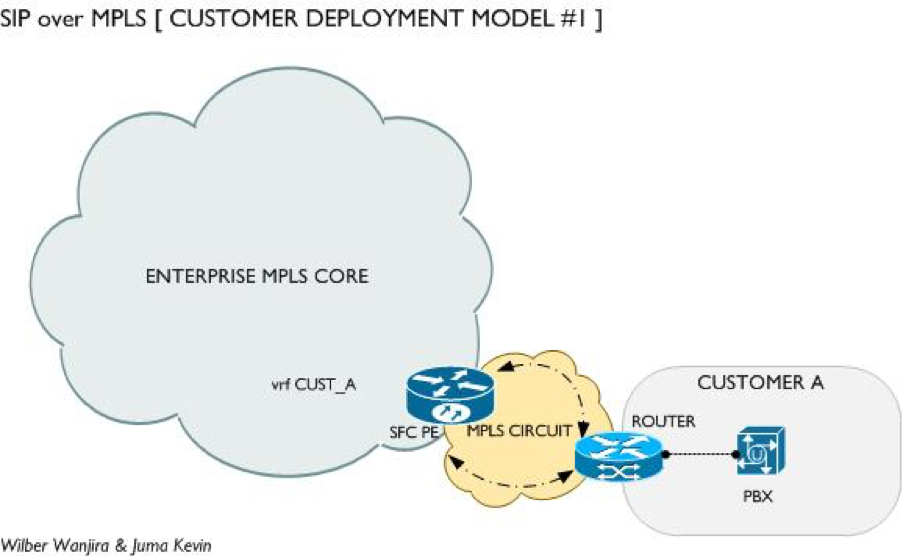
| Customer MPLS Block | SIP over MPLS Block | Protocol | WAN | LAN |
|---|---|---|---|---|
| 172.30.1.0/30 | 10.221.0.0/30 | EIGRP 456 | FastEth0/0 | FastEth0/1 |
#Customer Router Configurations
interface FastEthernet0/0
ip address 172.30.1.2 255.255.255.252
!
interface FastEthernet0/1
ip address 10.221.0.2 255.255.255.252
!
router eigrp SIPoMPLS
!
address-family ipv4 unicast as 456
!
topology base
exit-af-topology
network 10.221.0.0 0.0.0.3
network 172.30.1.0 0.0.0.3
!PBX will terminate on interface F0/2; directly or through a LAN switch. PBX port will be configured on the block range: on this example, the pbx IP will be 10.100.0.2/30 with a default gateway of 10.100.0.1 The block should be able to ping the SBC private MPLS IPs (Signaling and Media)
Deployment Model #2 - NAT
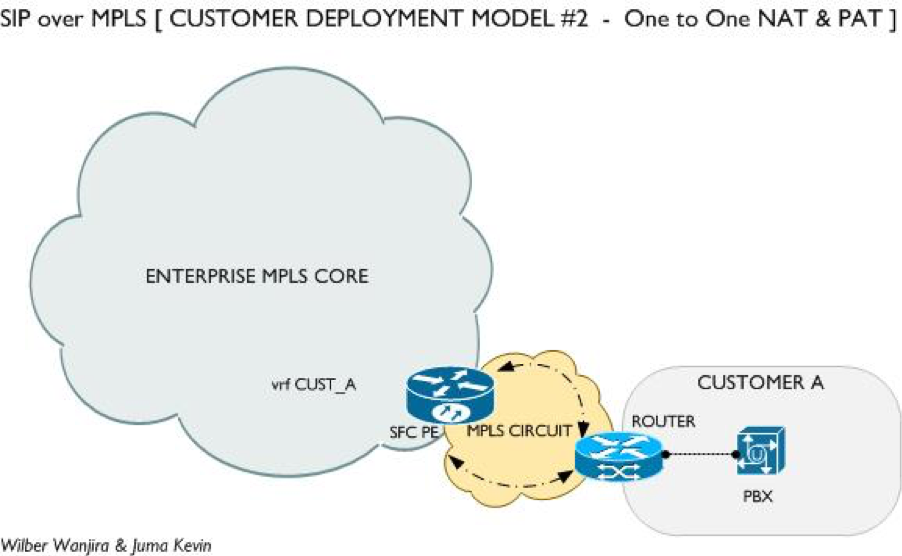
| MPLS Block | SIP over MPLS Block | Protocol | PBX IP | WAN | LAN |
|---|---|---|---|---|---|
| 172.30.1.0/30 | 10.221.0.0/30 | EIGRP 456 | 192.168.0.2 | FastEth0/0 | FastEth0/1 |
#Customer Router Configurations - one to one NAT
interface FastEthernet0/0
ip address 172.30.1.2 255.255.255.252
ip nat outside
!
interface FastEthernet0/1
description SIP
ip address 192.168.0.1 255.255.255.252
ip nat inside
!
!
router eigrp SIPoMPLS
address-family ipv4 unicast as 456
topology base
exit-af-topology
network 10.221.0.0 0.0.0.3
network 172.30.1.0 0.0.0.3
!
ip nat inside source static 192.168.0.2 10.221.0.2
!Deployed when customer already has an established PBX/ Voice LAN.Gateway of PBX has to be set to the router for NAT to function.
#Customer Router Configurations - PAT
access-list 114 permit udp any any range 10000 12000
ip nat pool voip-rtp 192.168.0.2 192.168.0.2 netmask 255.255.255.252 type rotary
ip nat inside source static udp 192.168.0.2 5060 10.221.0.2 5060 extendable
ip nat inside destination list 114 pool voip-rtpSignaling port 5060 | Media Port Range 10000 - 20000
Deployment Model #3 - Link terminates directly to PBX
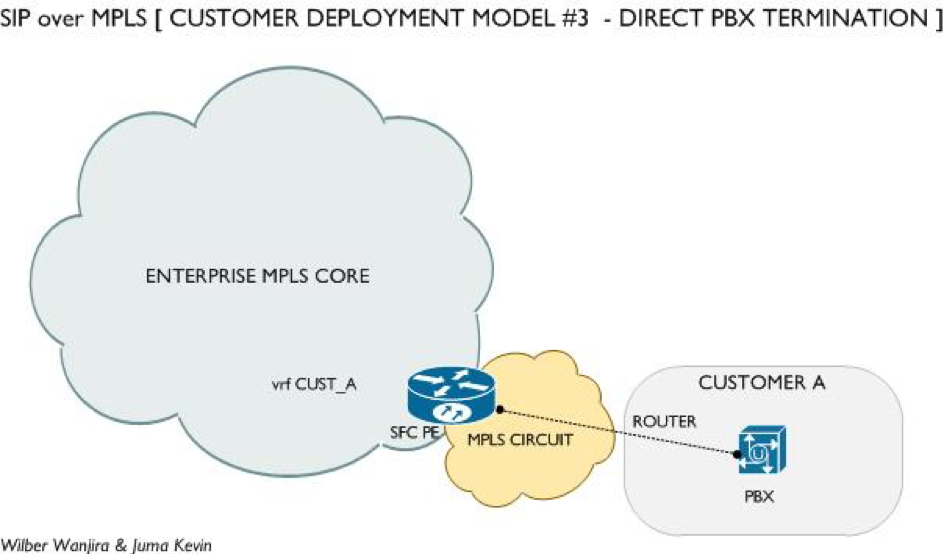
| MPLS Block | SIP over MPLS Block | Protocol | PBX IP | WAN Interface |
|---|---|---|---|---|
| 10.100.0.0/30 | x | Static Route | 10.100.0.0 | PBX WAN Interface |
MPLS IP configured on the PBX | PBX Gateway configured at the PE
SIPoMPLS - Service Implementation (SIPoMPLS-SAFARICOM-01)
Updated: 2015
